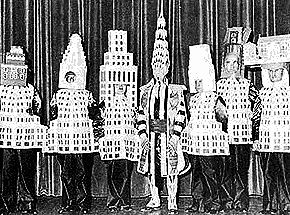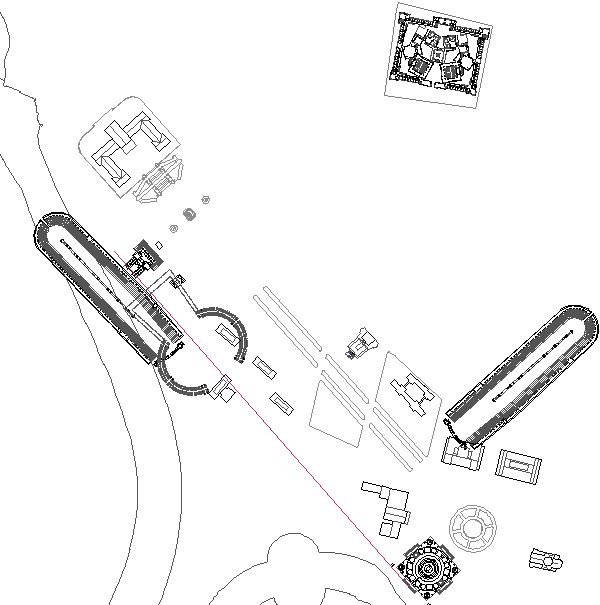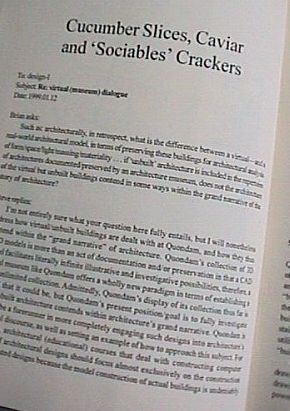2005.08.08 15:58
"How Did This Happen Revisited"
Last Friday I read about Vitruvius Britannicus in Architectural Theory: from the Renaissance to the Present (Taschen, 2003) and was surprised to learn:
"For Campbell St. Peter's is by no means merely an especially striking expression of architectural abuses on the Continent: it also stands for Italy's cultural decline. As such he emphasizes in his foreword that in the post-Palladian era Italy had not only become estranged from the true "taste of building," but also from the roots of its culture, the Latin language. From this perspective, Italy could no longer be the destination of the Grand Tour. Campbell considers such understandings to be "Mistakes in Education." As the Vitruvius Britannicus is intended to demonstrate, it is now the architects and artists of England who are to take Italy's place as the preservers of timeless, classical taste."
I cannot recall having ever read that Piranesi's oeuvre is in some ways a reaction to Vitruvius Britannicus, but I certainly see it that way now.
Vanbrugh begins "How Did This Happen Revisited" by pointing out the dates of the gardens of Versailles (1661-1668) and the plan of Philadelphia (1683), and from there it's an enlightening chronological list of events.
2005.08.08 16:54
Dubai: the city of the 21st century!
cellardoor whore, ever count how many times Allen, Bloomer, Eisenman and Kwinter tautologically reenact Tafuri when it comes to Piranesi? And you say tautology isn't funny. You're right. It's hilarious.
"reenactment is reenactment" -- that reenacts Stein, right?
"there is a fold" -- that reenacts Deleuze, right?
"it is no longer really of significance" -- that's multiple choice, right?
2005.08.09 14:58
"How Did This Happen Revisited"
"This is in line with traditional sociological accounts of the formation of taste, which are inclined to stress the desire for status, either in terms of imitation within a social group, of emulation of a superior social group, or differentiation from one below, as the most powerful motivating force in culture.
The problem with this type of cultural analysis it that it relies on a reading of subconscious motivation. Few individuals are so brazen as to admit, even to themselves, that they buy art [or love Rita Novel] or even build great architecture out of a straightforward desire to provide visible bulwarks to their social or political positions."
--The Building of Castle Howard
| |
2005.08.09 15:05
archinecters@theEncantadas.sex

See what happens after some archinecters smoke an expansion joint. Plus, they forgot to put up the VACANCY sign!
2005.08.11 11:17
the agnostic design of spiritual space
The original Cedar Grove Church just up the street is now a gymnasium. Over on Rising Sun Avenue, the old Murianka Funeral Home used to be a Portuguese church, but is now the base of a Black congregation, Triumphal-something-something-something. Then up the road, the old Kolping House, a Catholic home for German immigrant men was knocked down to make way for the RiteAid. And directly across the street, the quondam Fleur's Funeral Home is now the Lutheran Family Community Center, whose neighbor, once a big single house, is now a Cambodian Buddhist Temple. Gosh, from where I'm at, architects, agnostic or otherwise, aren't needed at all when it comes to making a spiritual space.
2005.08.11 11:34
the agnostic design of spiritual space
The weirdest thing about all the "spiritual spaces" of my immediate neighborhood is that they are clustered around the intersection of Rising Sun Avenue and Tabor Road, which actually may have been a Lenni-Lenape (summer) solstice celebration site. (Hence my living in what used to be an ancient burial site.)
The Lenni-Lenape trail that is now Rising Sun Avenue culminated at the high-point where Tabor Road crosses Rising Sun Avenue. Tabor Road dates back to 1776, albeit still under George III. Its purpose was to give the Church of England faithful living in Germantown access to Trinity Episcopal Church (many miles east) on Oxford Avenue (which was another Native American trail).
| |
2005.08.11 14:53
"I'm a believer": author of 'the Da Vinci Code' defends marriage of Christ theory
Leaving Obscurity Behind
the Horace Trumbauer Architecture Fan Club Convention
18 August 2005
Pilgrimage, Reenactment and Tourism
presented by Flavia Julia Helena Augusta at Eakins Oval, the Benjamin Franklin Parkway, Philadelphia

| |
2005.08.11 15:25
archinecters@theEncantadas.sex
It's been quiet on the islands because everyone's reading...

...or maybe everyone's busy otherwise behind closed doors.
2005.08.14 09:14
Old Architectural Prints on EBAY
All the pre-1900 architectural prints I've bought and sold on eBay are real.
There are around 500 prints in my basement now that I keep on thinking I'll offer some day at eBay.
That, or I'll color some of them, or collage some of them, or wallpaper my bathroom with some of them.
2005.08.14 12:33
the agnostic design of spiritual space
If you'd really like to see "church" architecture change, just imagine religious institutions without tax exemption.
You can thank Constantine for starting that law.
|